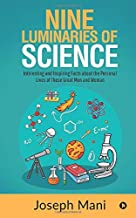In this wonderful book, author Joseph Mani documents the personal life of nine well-known men and women who have played a major role in the development of modern science.
Every person’s life is, without exception, a fascinating story in itself. Each such story recounts how an individual has negotiated with the mere fact of being alive. Even simply because of this, it has at least something that others can gain from. One can draw valuable lessons from the life-story of even someone who is considered very ‘ordinary’ and ‘unremarkable’. That said, learning about the life of people who have made outstanding contributions that have benefitted many others can be a great joy as well as a major inspiration.
In this wonderful book, author Joseph Mani documents the personal life of nine well-known men and women who have played a major role in the development of modern science and whose contributions have had an important impact on the world. He provides us with an engaging account of how the life of these noted individuals unfolded over time and how they were led to make the scientific inventions or discoveries that they did.

Era of Modern Science
The nine characters that the author highlights are Nicholas Copernicus (b.1473), Galileo Galilei (b. 1564), Isaac Newton (b.1642), Marie Curie (b.1867), Jagdish Chandra Bose (b.1858), Albert Einstein (b.1879), C.V. Raman (b.1888), Richard Fenyman (b.1918) and Stephen Hawking (b.1942). Taken together, their period covers a span of some 500 years, marking the emergence and development of what is considered to be the era of modern science.
The author’s description of the life of these nine scientists is not intended to be a detailed biographical account. Nor does it deal in detail with their various scientific works (which would perhaps require an entire book for almost every case). Rather, the book seeks to highlight how these noted scientists were as persons, rather than just as scientists as human beings who had their genius, no doubt, but who also had their faults and, in some cases, idiosyncrasies, just like the rest of us. Condensing their life-stories into just a chapter each, the book provides us with interesting insights into what for most of us is a lesser-known side of their personality. We get to know them as persons, rather than just as scientists. We learn, for instance, of their family background and education. We discover something about the great odds some of them had to face in their scientific quest, including from ‘religious’ authorities, as well as economic hardships and struggles. We learn about troubled marriages and tangled personal relationships. We also come to know about the oddities of some of these people, which we might never had expected of a ‘famous’ scientist (for instance, did you know that Richard Fenyman, considered one of the world’s greatest theoretical physicists in the area of quantum mechanics and who won the Nobel Prize for Physics in 1965, refused to brush his teeth and also advised others not to do so on TV? Or, were you aware that the late Stephen Hawking delighted in riding his wheelchair over the toes of people he disliked?). The book also provides fascinating details about the religious beliefs (or lack of them) of some of the world’s most well-known scientists: some of them believed in God (understood diversely), while some others were atheists.
Early Childhood Experiences
This beautiful book highlights multiple factors that go into the making of a ‘great’ scientist. It suggests that perhaps it isn’t some supposed innate academic ‘brilliance’ alone that counts here. Other factors, such as early childhood experiences, relationships at home, difficult economic conditions, personal encounters and even emotional challenges can also have a powerful impact on individuals, leading them, in ways one would never have imagined, to go on to become famous scientists.
As an introduction to the fascinating life of nine people who have made a major contribution to modern science, this book excels. Written in an easy, relaxed style, it can resonate with both school students and ‘adults’ alike. The author deserves our thanks for providing us a thoroughly-engaging account of the personal side of these men and women, which we may completely ignore even as we may benefit in many ways from their scientific achievements.
That said, I have just one complaint: we aren’t told about why the author chose these particular nine scientists to profile. And why nine, and not say, ten, the closest round-figure? And then again, why not scientists from other parts of the world and civilisational zones? Highlighting the life of scientists from diverse religious and cultural backgrounds would probably have added to the richness of this book. But perhaps that is something that Joseph Mani will deal with in a future book!

COMMENTS